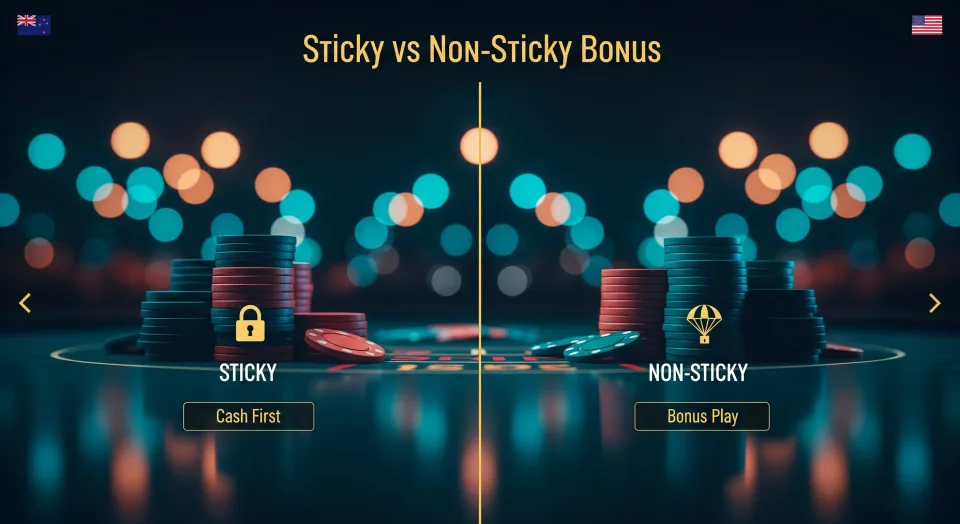If you’ve ever claimed a welcome offer and then struggled to cash out, the difference between a sticky vs non-sticky bonus is the first thing to understand. A sticky bonus lets you play with extra funds, but the bonus itself isn’t withdrawable and is removed when you cash out. A non-sticky bonus (often called a parachute bonus) keeps your cash first and only activates bonus funds if your cash balance hits zero. This guide explains how both structures work, what wagering requirements really mean, and how NZ & US players can choose smarter deals based on goals, games, and risk tolerance. By the end, you’ll know exactly when a sticky vs non-sticky bonus makes sense—and when to skip the promo entirely.
Sticky vs Non-Sticky Bonus: Quick Definitions
What is a sticky bonus?
A sticky bonus (sometimes called “locked” or “non-cashable”) is credit you can bet with, but the bonus principal is not withdrawable. After you complete wagering requirements (WR) and request a withdrawal, the casino deducts the bonus amount and pays only your eligible winnings. Sticky offers often headline bigger match percentages or larger caps, but the trade-off is reduced flexibility when you want a fast cash-out.
What is a non-sticky bonus (parachute)?
A non-sticky bonus separates balances. You play with cash first; if you win during the cash phase, you can usually withdraw immediately and forfeit the unused bonus. If your cash hits zero, the bonus activates and you continue under bonus rules. This structure is popular with players who want a clean path to withdraw early wins without grinding WR.
Wagering Requirements for Sticky vs Non-Sticky Bonuses
Wagering requirements specify how much you must bet before you can withdraw. They’re expressed as a multiple, such as 25×, 30×, 35×, or 40×. The base matters more than most people realise:
-
Bonus-only WR: $100 bonus at 35× = $3,500 in qualifying bets.
-
Deposit + bonus WR: $100 deposit + $100 bonus at 35× = $7,000—twice as hard to clear.
Game weighting controls how much each bet counts toward WR. Slots commonly contribute 100%; many table games and live dealer titles contribute 10% or 0%; some games are excluded entirely. Always check the contribution table and any exclusions before you start—what looks like a friendly “35×” can feel very different depending on the base and the games you actually play.
For non-sticky offers, only the bonus phase typically needs to meet WR because cash-phase wins can be withdrawn immediately. For sticky offers, all play may contribute toward WR, but remember the bonus principal is removed at payout.
How Each Bonus Works (Step by Step)
Sticky bonus flow
-
Deposit; the sticky bonus is added to your playable balance (non-cashable).
-
Play and progress WR using eligible games at their contribution rates.
-
When WR is finished, request withdrawal; the casino deducts the bonus amount and pays remaining eligible funds.
Non-sticky (parachute) bonus flow
-
Deposit; the non-sticky bonus is credited but inactive.
-
Play with cash first. If you win and withdraw before the bonus activates, you keep your cash winnings and the bonus is forfeited.
-
If cash hits zero, the bonus activates and you continue under WR and bonus rules.
-
Complete WR to withdraw any bonus-derived winnings (respect max-bet caps and expiry).
Pros and Cons of Sticky vs Non-Sticky Bonuses
Sticky bonus — where it fits
Pros: Typically larger headline amounts, long playtime, straightforward “one pot” feel during play.
Cons: Bonus principal is removed on cash-out; offers often come with higher WR, tighter max bets, and stricter game limits.
Non-sticky bonus — where it shines
Pros: Cash-first flexibility; clean path to withdraw early wins; excellent for risk-managed sessions or high-volatility slots in cash phase.
Cons: Smaller headline bonuses are common; once the bonus activates, you still face WR and any restrictions.
Which Bonus Type Should NZ & US Players Choose?
For NZ players at reputable international brands and US players in state-licensed markets, the choice hinges on your goals:
-
Fast cash-out mindset: Non-sticky is ideal. Take a shot with cash; if it pops, withdraw and skip the grind.
-
Entertainment time: Sticky can suit longer sessions if you accept that the bonus itself isn’t withdrawable and WR may be higher.
-
Table-game fans: Weighting matters more than structure. If blackjack, baccarat, or roulette contribute poorly (or not at all), consider cash-only or look for promos with fair table contributions.
No matter which path you pick, make sure the operator is properly licensed and transparent. For authoritative guidance on fair terms and consumer protections, review the UK Gambling Commission (https://www.gamblingcommission.gov.uk/) and the Malta Gaming Authority (https://www.mga.org.mt/). These two sources help you sanity-check promotion wording and understand your rights around disputes and withdrawals.
Common Bonus Terms to Check Before You Claim
-
WR base & size: Prefer bonus-only over deposit+bonus. A 25×–35× bonus-only range is typical; higher numbers reduce value quickly.
-
Game weighting: Confirm 100% slots lists, partial contributions, and exclusions. Progressive jackpots are usually excluded from WR.
-
Max bet while bonusing: Often $5–$10 (or ~0.5–1% of bonus). Exceeding caps can void bonus-derived winnings.
-
Maximum cash-out: More common on no-deposit or some sticky offers; high-rollers should read this line twice.
-
Expiry window: WR periods frequently span 7–30 days. Start only if you can finish in time.
-
Payment method eligibility: Certain cards, e-wallets, or crypto deposits may be excluded from bonuses.
-
Irregular play clauses: Hedge betting, extreme volatility hopping, or other prohibited strategies can trigger forfeits.
Worked Examples You Can Follow
Example A: Sticky bonus (bonus-only WR)
You deposit $100 and receive a $100 sticky bonus at 35× bonus-only. Target WR is $3,500. After play, your balance shows $420. At withdrawal, the casino deducts $100 (the sticky principal) and pays $320, assuming all terms were followed. If the offer had been 35× deposit + bonus, the target would jump to $7,000.
Example B: Non-sticky bonus — early cash-out
You deposit $100 and receive a $100 non-sticky bonus. You play on cash first and run up to $260. You withdraw immediately; the unused bonus is forfeited and no WR applies because you never entered bonus phase.
Example C: Non-sticky bonus — bonus phase
Your $100 cash busts; the $100 bonus activates at 35× (target $3,500). You grind with eligible slots and finish at $260. Because non-sticky bonuses are cashable once WR is met (subject to any caps), you withdraw $260—no deduction for the bonus amount.
Strategy Tips: Make the Structure Work for You
-
Cash-first discipline (non-sticky): Start with a variance profile that matches your goal. Many players choose medium/high-volatility slots to chase an early pop. If it lands, withdraw and leave. If not, accept the safety net of the bonus and switch to lower-variance titles to clear WR efficiently.
-
Long-session value (sticky): When playtime is your priority, a larger sticky headline can be fine—provided WR is reasonable and your preferred games actually contribute. Track progress and avoid stake sizes that violate max-bet rules.
-
Table games and live dealer: Contribution rates are often low or zero. If you primarily play blackjack, baccarat, or roulette, the effective WR may be impractical regardless of structure. Consider cash-only play or hunt for promos that specifically allow decent table contribution.
-
Banking & verification: Complete KYC early so a surprise win doesn’t get delayed. Make sure your preferred payment method qualifies for bonuses and withdrawals.
Responsible Gambling & Practical Checks
Set a budget first—bonuses should extend entertainment, not justify overspending. Screenshot the terms—promotions change; keeping a record protects you if wording is updated mid-promo. Take regular breaks, use deposit and loss limits, and consider time-outs if you feel pressure to “finish WR at all costs.” The right sticky vs non-sticky bonus choice is the one that fits your temperament and time, not just the headline percentage.
Bottom Line: Picking Between a Sticky vs Non-Sticky Bonus
If your priority is control and quick exits, the sticky vs non-sticky bonus comparison usually points to non-sticky: you get cash-first play and a clean route to withdraw wins with no WR grind. If your goal is more playtime and you’re comfortable with a grind, a well-structured sticky offer can still deliver value—just accept that the bonus principal won’t be paid out and verify WR, contribution rates, max bet, caps, and expiry before you claim.

